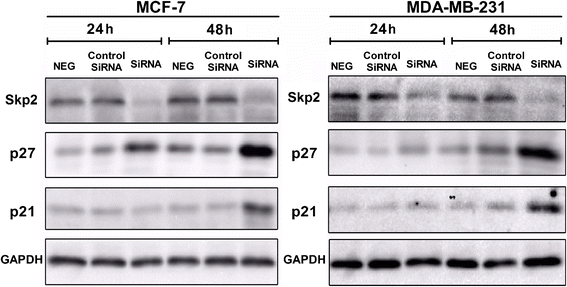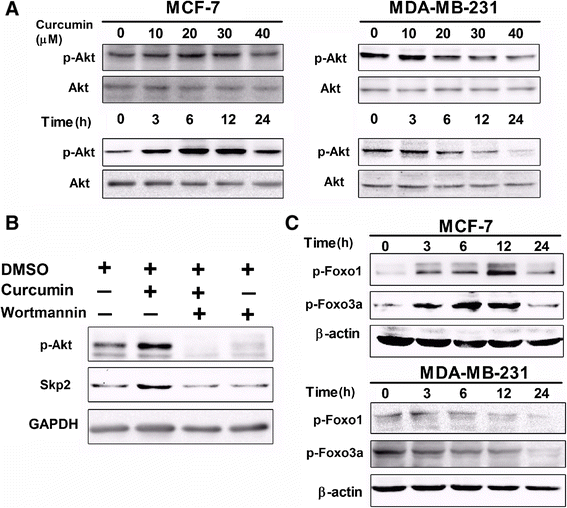The differential susceptibilities of MCF-7 and MDA-MB-231 cells to the cytotoxic effects of curcumin are associated with the PI3K/Akt-SKP2-Cip/Kips pathway
- PMID: 25530715
- PMCID: PMC4272549
- DOI: 10.1186/s12935-014-0126-4
The differential susceptibilities of MCF-7 and MDA-MB-231 cells to the cytotoxic effects of curcumin are associated with the PI3K/Akt-SKP2-Cip/Kips pathway
Abstract
Background: The mechanism underlying the differential cytotoxicity of curcumin in various cancer types, however, remains largely unclear. The aims of this study is to examine the concentration- and time-related effects of curcumin on two different breast cancer cells, MCF-7 and MDA-MB-231, and investigated the functional changes induced by curcumin treatment, as well as their relationship to the PI3K/Akt-SKP2-Cip/Kips pathway.
Methods: First, WST-1 and clonogenic assay were performed to determine the cytotoxicity of curcumin in MCF-7 and MDA-MB-231 cells. Then, the expression of CDK interacting protein/Kinase inhibitory protein (Cip/Kips) members (p27, p21 and p57) and S-phase kinase-associated protein-2 (SKP2) was investigated by QRT PCR and Western Blotting. Curcumin's effect on PI3K (phosphatidylinositol 3-kinase) /Akt and its substrates Foxo1 and Foxo3a were then studied by Western Blotting. Small interfering RNAs (siRNAs) targeting SKP2 was used to explore the relationship between SKP2 and Cip/Kips members. Finally, WST-1 assay was tested to explore the concomitant treatment with curcumin and the inhibition of PKB or SKP2 signaling on curcumin sensitivity in MCF-7 and MDA-MB-231 cells.
Results: We demonstrated MCF-7 and MDA-MB-231 cells exhibited differential responses to curcumin by WST-1 and clonogenic assay (MDA-MB-231 cells was sensitive, and MCF-7 cells was resistant), which were found to be related to the differential curcumin-mediated regulation of SKP2-Cip/Kips (p21 and p27 but not p57) signaling. The differential cellular responses were further linked to the converse effects of curcumin on PI3K/Akt and its substrates Foxo1 and Foxo3a. Importantly, PI3K inhibitor wortmannin could counteract both curcumin-induced phosphorylation of Akt and up-regulation of SKP2 in MCF-7 cells. Subsequent WST-1 assay demonstrated concomitant treatment with curcumin and wortmannin or SKP2 siRNA not only further augmented curcumin sensitivity in MDA-MB-231 cells but also overcame curcumin resistance in MCF-7 cells.
Conclusions: Our study established PI3K/Akt-SKP2-Cip/Kips signaling pathway is involved in the mechanism of action of curcumin and revealed that the discrepant modulation of this pathway by curcumin is responsible for the differential susceptibilities of these two cell types to curcumin.
Keywords: Breast cancer; Cip/Kips; Curcumin sensitivity; FOXO; PI3K; SKP2.
Figures






References
-
- Heiser LM, Sadanandam A, Kuo WL, Benz SC, Goldstein TC, Ng S, Gibb WJ, Wang NJ, Ziyad S, Tong F, Bayani N, Hu Z, Billig JI, Dueregger A, Lewis S, Jakkula L, Korkola JE, Durinck S, Pepin F, Guan Y, Purdom E, Neuvial P, Bengtsson H, Wood KW, Smith PG, Vassilev LT, Hennessy BT, Greshock J, Bachman KE, Hardwicke MA, et al. Subtype and pathway specific responses to anticancer compounds in breast cancer. Proc Natl Acad Sci U S A. 2012;109:2724–2729. doi: 10.1073/pnas.1018854108. - DOI - PMC - PubMed
-
- Lopez-Lazaro M. Anticancer and carcinogenic properties of curcumin: considerations for its clinical development as a cancer chemopreventive and chemotherapeutic agent. Mol Nutr Food Res. 2008;52(Suppl 1):S103–S127. - PubMed
LinkOut - more resources
Full Text Sources
Other Literature Sources
Molecular Biology Databases
Research Materials
Miscellaneous

